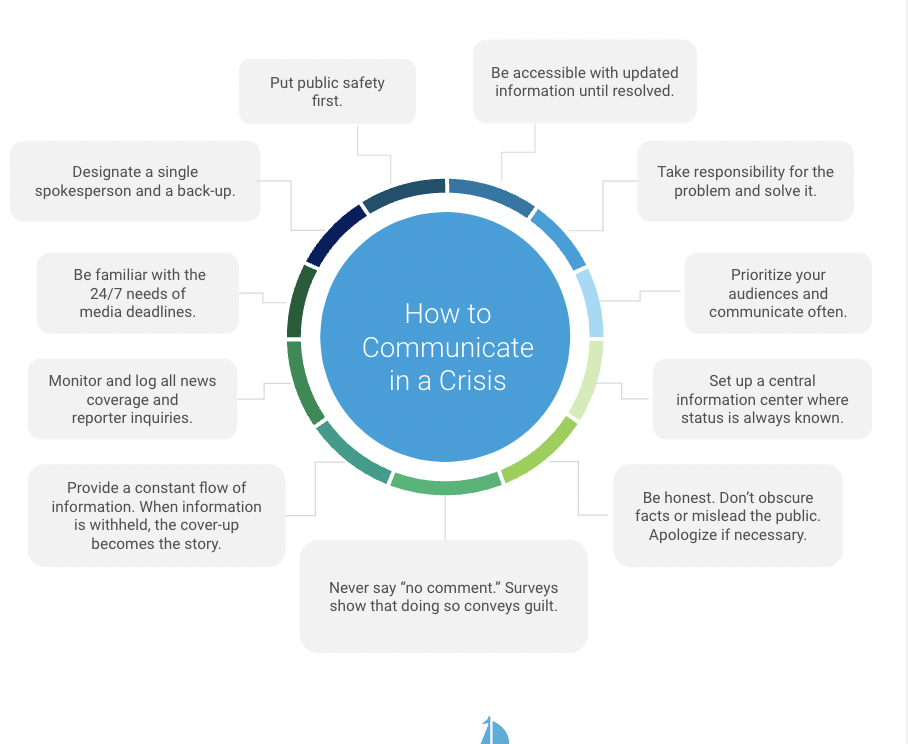One never knows when a crisis will occur. When it does, often, the first call is made to legal counsel who then recommends a PR firm. The smartest leaders prepare their organizations and teams with a proactive, well-thought out reputation management plan before irreparable and mounting damages could take over.
Scenario: Your organization faces a crisis that could tarnish a clean record – a product failure, a lawsuit, an employee incident, an event that threatens public safety or lack of deliberate positioning on world affairs. How do you communicate effectively to minimize damage while maintaining trust or rebuilding a reputation? To be or not to be in the news marks one question. And that’s where we enter.
Priorities
- Share the facts fast and indicate how the situation evolved. Legendary leader and investor, Warren Buffet, once said, “Get it right. Do it fast to get it out and get it over.” You can too by creating a single command center for a flow of accurate and real-time information and utilizing a prior-developed issues, risks and crises playbook that includes a 12-step tactical approach.
- Place public safety high: indicate risks, mitigation efforts and what is going to be done differently.
- Don’t remain silent. Silence equals suspicion from the public and your internal teams. Reporters have a job to do. Their stories will fill in the blanks if you don’t. Develop a way to be a thought leader among a sea of others foolishly choosing silence.
- Success can mean preparing a thought leadership position through opinion editorials (op-ed). An example is the Abbott Laboratories CEO writing an op-ed in The Washington Post to address the nationwide baby formula shortage, apologizing for a voluntary recall of its formula and ensuring it would invest in upgrading safety and quality processes and equipment to ensure it will never have to stop making critical products for parents such as baby formula.
- Know the needs of your stakeholders (your employees, investors, customers, prospects, partners, the news media and the communities where you operate).
- Communicate actively and often, addressing specific concerns where possible.
Lead with honesty and transparency
- Honesty: remain truthful about the situation and select a believable spokesperson, especially on air. Do not hide or manipulate facts. Acknowledge any mistakes and sincerely apologize.
- Pepsi featured an ad with Kendall Jenner giving a police officer a can of the soda during a protest that was widely criticized for being tone-deaf and appropriating the Black Lives Matter movement. Pepsi quickly pulled the ad and issued a sincere apology, acknowledging that they had “missed the mark.” Prompt responses help limit damage to one’s reputation.
- Open communication: regularly share updates with the public, even if it’s incomplete information, and address rumors and misinformation proactively.
Engaging the news media
- Media savvy: understand the 24/7 news cycle and reporter deadlines and be prepared to respond promptly and efficiently.
- Designate a credible spokesperson: choose spokespeople who can clearly articulate your message. Have a primary choice and a backup.
- Apple faced accusations of deliberately slowing down older iPhone models through software updates to encourage users to upgrade. CEO Tim Cook addressed the issue publicly, acknowledging the slowdown but attributing it to a performance optimization feature aimed at protecting battery health. It showcased the importance of providing technical details and rationale in a crisis. Compared to the year prior, the crisis did not hurt its reputation or revenue.
- Accessibility: make the organization available for interviews and questions. Answer all queries thoroughly. Never resort to “no comment.” A brief emailed statement with a quotable source suffices.
- Even seasoned journalists make mistakes. Course correct them using facts to make sure a client is accurately represented. For instance in an antitrust case representing a defendant, a large verdict was handed down by the jury. When covering the case, some journalists’ incorrectly used the term ‘guilty,’ only relevant to criminal trials, versus the correct term for a civil case which is ‘liable’ for the damages. Many journalists updated the language so that archived stories did not live online with the wrong characterization.
(Re) Positioning your organization
- Accountability: take responsibility for the problem and actively work toward a solution. Clearly communicate your commitment to accountability and resolving the issue.
- Transparency: establish a central information hub with ongoing updates on the situation.
- If this is a legal situation, establish a cadence with in-house counsel for frequent briefs. When all teams align, the right decisions for managing a crisis are likely to be made.
- Anticipate: develop holding statement drafts based on certain scenarios (win, loss, settlement hung jury). Draft an op-ed on a topic that pertains to the trial for maximum thought leadership representation.
- Work with trusted, conscientious journalists to tell your story.
- Openness fuels trust and understanding with your stakeholders including news media and the public to overcome any crisis and emerge stronger by the way you handle one. In the end, many of the details won’t matter compared to how you navigate and lead through challenges.
With a strong plan, you can escape the damaging cycle of reputation problems and crises. It helps you minimize harm, rebuild trust and emerge stronger. No matter your industry or situation, a solid strategy and dynamic process prepares you well. Call Ballast when your organization or law firm’s clients are in a pinch as numerous organizations in consumer goods, higher education, healthcare, technology, and real estate industries have done.




